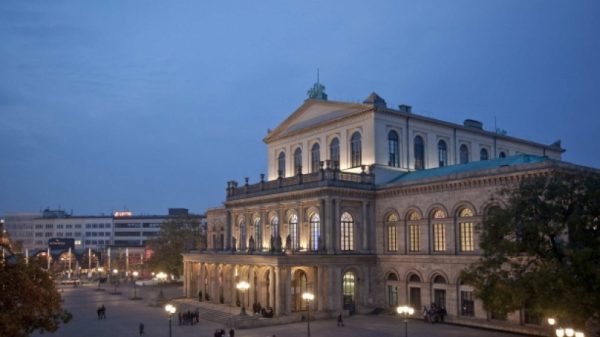 Germany Verdi, Otello: Soloists, Chorus and Extras of Staatsoper Hannover. Niedersächsisches Staatsorchester Hannover / James Hendry (conductor). Staatsoper Hannover, 7.1.2024. (DMD)
Germany Verdi, Otello: Soloists, Chorus and Extras of Staatsoper Hannover. Niedersächsisches Staatsorchester Hannover / James Hendry (conductor). Staatsoper Hannover, 7.1.2024. (DMD)

Production
Director – Immo Karaman
Stage design – Etienne Pluss
Costume design – Gesine Völlm
Lighting design – Susanne Reinhardt
Video – Philipp Contag-Lada
Movement director – Fabian Posca
Dramaturgy – Regine Palmai
Revival director – Valérie Junker
Chorus director – Lorenzo Da Rio
Cast
Otello – Andeka Gorrotxategi
Jago – Daniel Miroslaw
Cassio – Marco Lee
Roderigo – Fabio Dorizzi
Lodovico – Markus Suihkonen
Montano – Richard Walshe
Desdemona – Kiandra Howarth
Emilia – Ruzana Grigorian
The lights in the auditorium go down and off, the black curtain within the frame of the stage goes up, and in a sparsely decorated room with grey-green walls, a 1960s fridge-freezer, table with chairs and a mattress with blanket and pillow on the floor, a man in his early 40s, dressed in trousers, T-shirt and worn-out bathrobe, tumbles around as if in delirium, hits out at the empty space with a baseball bat and collapses on the mattress. The frame of the room is demarcated by white strip lights which now turn on, to coincide with the first ferocious bars of music from the orchestra pit. What appeared to have been the back wall of the room framed by white strip lights rises — to reveal a smaller version of the same room – altogether there are five or six of these rooms, identical and strangely different at the same time. They are the nightmare, the delirium, of Otello, the man in the bathrobe, the war veteran, the soldier just returned from war, the victim of some horrible experiences, suffering from massive post-traumatic stress disorder, beyond anyone’s help. Desdemona is his wife, takes care of him, within the context of financial restrictions suggested by the shabbiness of the room(s). She bears his mood swings, his aggression. The events of the opera happen in that world of trauma, characters are revealed and concealed by the walls of the multiple room(s), and the audience are as uncertain of what is real and what is not as is Otello himself. Such a state of mind must be frightening – that much is clear. Director Immo Karaman, with the support of dramaturg Regine Palmai, has developed a cogent concept for this 2021 production, now revived by Valérie Junker. The multiple rooms, with their perspective of right to left rather than centred in Etienne Pluss’s set provide ample examples of subtle nightmare. The grey colours of the soldiers’ uniforms (costumes by Gesine Völlm) are cleverly juxtaposed with the more colourful ones of the welcome home party. Susanne Reinhardt’s lighting serves the creation of moods efficiently, enhanced at times by the video projections designed by Philipp Contag-Lada (for example, white noise from an old-fashioned malfunctioning TV set superimposed onto the characters who are celebrating the return).

James Hendry, First Kapellmeister at Staatsoper Hannover, is in charge of the Staatsorchester for this revival. He has made the score his own, conducting with broad gestures that demonstrate his commitment. Intense passages become exciting without overwhelming the singers’ voices or the spectators’ ears. The different instruments remain audible at all times, never succumbing to an anonymous and vague tapestry of sound. Gentle and lyrical passages are rendered with subtlety without turning into kitsch.
The production employed a movement director (Fabian Posca), and Andeka Gorrotxategi as Otello, in his debut on the stage of the Staatsoper Hannover, does him credit: he is a convincing actor to start with. He has got the vocal stamina for the title role and will grow further into it over time – this is only the second production since his role debut. Currently, while there are many promising elements, he has not yet achieved the flowing essence, the wholeness, which comes across, for example, in his video of Nessun dorma. In Otello, he still needs to push up his voice too much to reach the exposed high notes, although once reached, they have an exciting ring to them.
Daniel Miroslaw was a powerful Iago, roundly and expressively singing across the range of the emotions the character feels or feigns (rather than having to revert to barking, shouting, or otherwise sacrificing beauty of tone to achieve the expression of evil). He trusted the music, and rightly so. Kiandra Howarth as Desdemona sang with a very narrow, fast vibrato throughout, which overshadowed tonal beauty both in dramatic as well as gentle passages, including the A-flat in the Ave Maria.
With a strong company of resident singers, Hannover Staatsoper can afford to cast the minor parts with artists who would also be seen and heard in leading or title roles for other productions (rather than those singers appearing in one minor role after the other). Marco Lee (Nemorino, Ferrando, Rodolfo) was thus a strong, lively, and convincing Cassio, Richard Walshe (Figaro, Escamillo) authoritative as Montano, and Markus Suihkonen (Sparafucile) commanding as Lodovico. Fabio Dorizzi is a member of the International Studio of the Staatsoper Hannover and contributed a promising Roderigo. Ruzana Grigorian (Carmen, Amneris) was appropriately subdued as Emilia and only in the chorus scenes did she allow her voice full flow. The members of chorus, directed by Lorenzo Da Rio, were well coached by the movement director and they sang with an admirable level of commitment and unison.
Daniel Meyer-Dinkgräfe
Featured image: Staatsoper Hannover © Staatsoper Hannover
